Analysis of Competitive Strategies: RBV, Porter's, and SWOT Frameworks
VerifiedAdded on 2022/09/18
|9
|1966
|25
Report
AI Summary
This report provides an in-depth analysis of three major competitive strategy formulation tools: Resource-Based View (RBV) framework, Porter's Five Forces framework, and the SWOT analysis tool. The report explains each framework, illustrating their application with real-world examples. The RBV framework is explained using Walmart as a case study, analyzing its strategic resources, core competencies, and competitive advantages through the VRIO framework. Porter's generic strategies are examined using Apple Inc. as an example, highlighting its broad differentiation strategy. Finally, the SWOT framework is applied to Amazon.com, identifying its strengths, weaknesses, opportunities, and threats. The report concludes by emphasizing the importance of the SWOT and Porter's frameworks for developing effective competitive strategies and maintaining a competitive edge. The analysis provides valuable insights into how businesses can leverage these frameworks for strategic planning and achieving their goals.
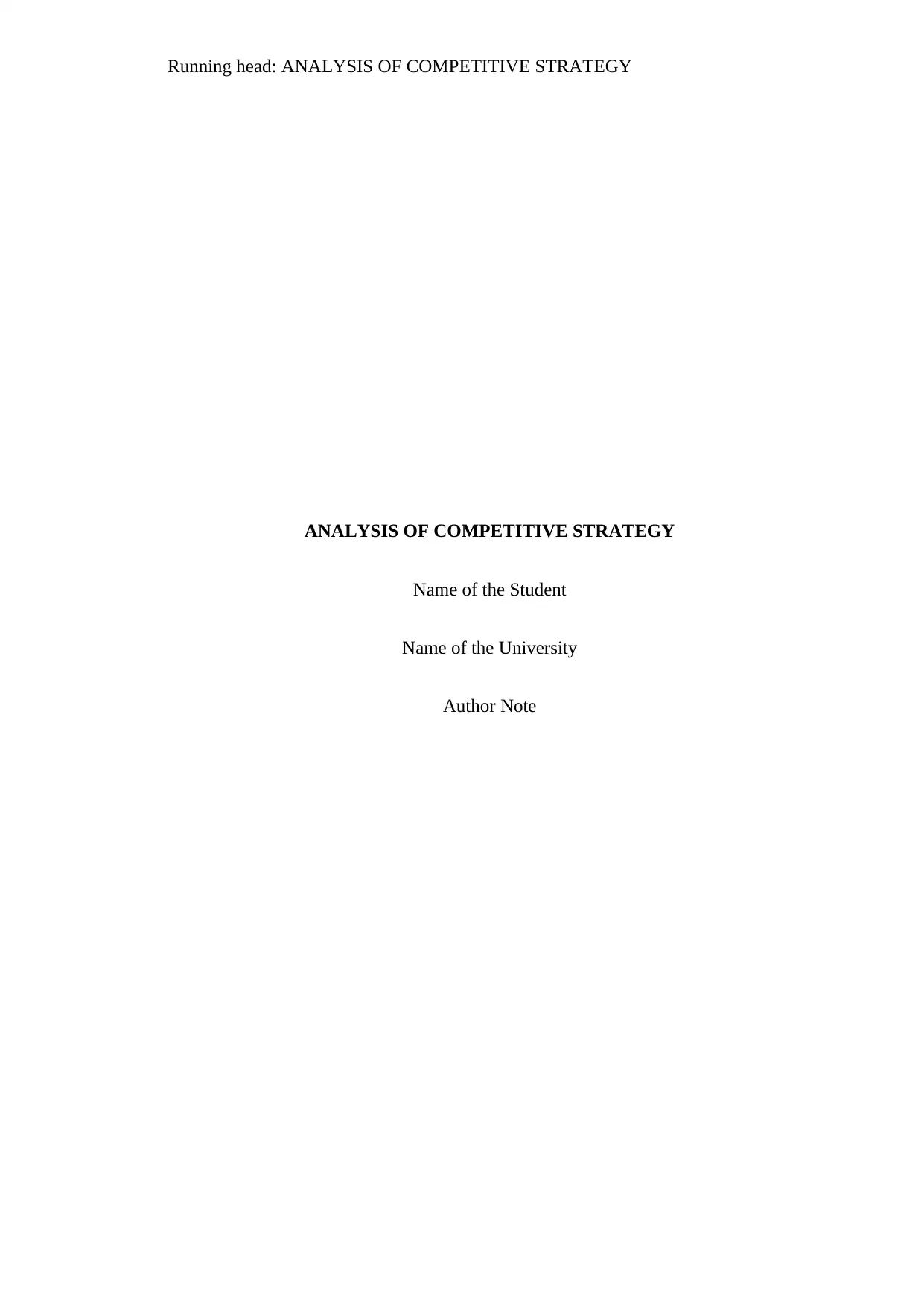
Running head: ANALYSIS OF COMPETITIVE STRATEGY
ANALYSIS OF COMPETITIVE STRATEGY
Name of the Student
Name of the University
Author Note
ANALYSIS OF COMPETITIVE STRATEGY
Name of the Student
Name of the University
Author Note
Paraphrase This Document
Need a fresh take? Get an instant paraphrase of this document with our AI Paraphraser
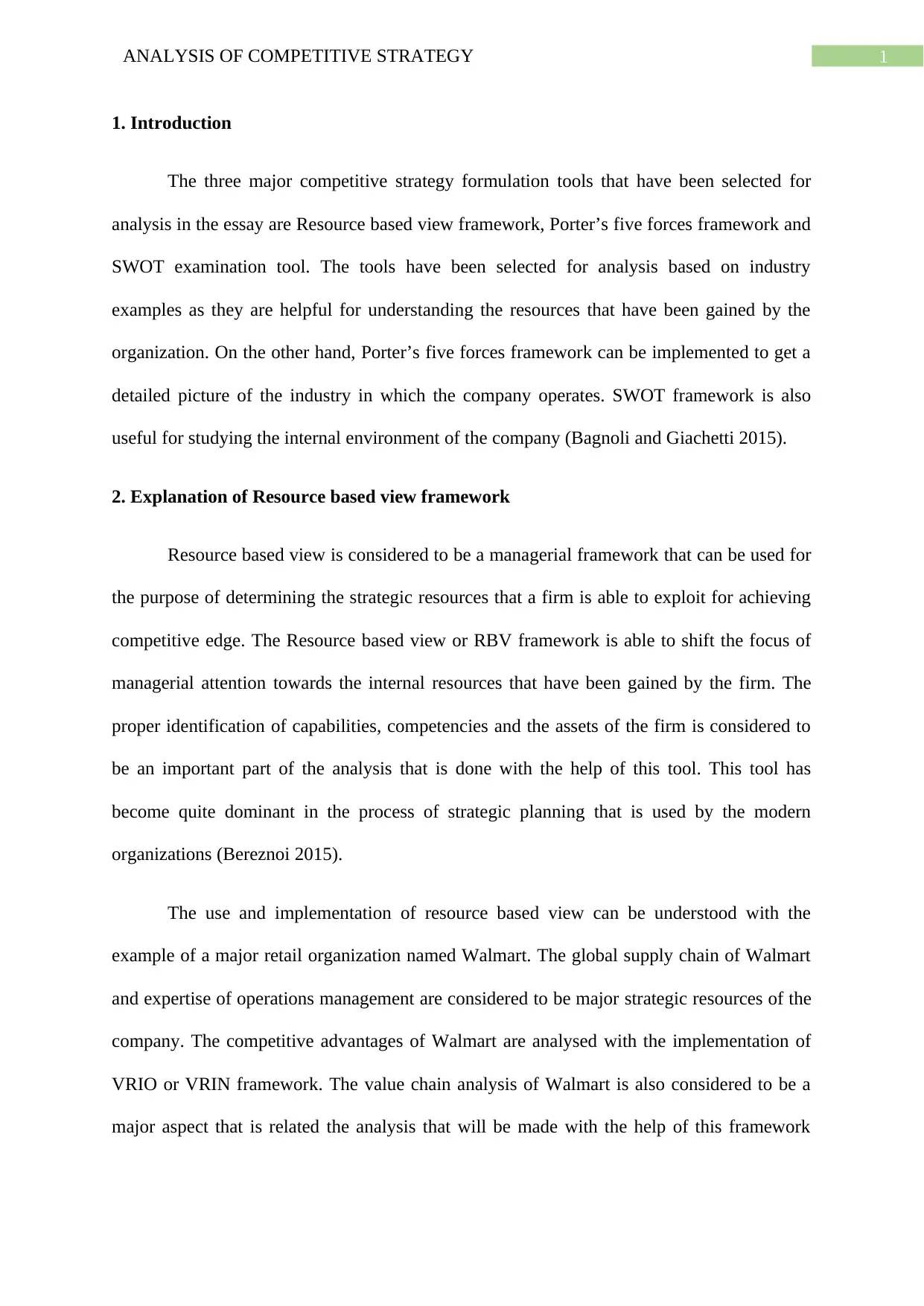
1ANALYSIS OF COMPETITIVE STRATEGY
1. Introduction
The three major competitive strategy formulation tools that have been selected for
analysis in the essay are Resource based view framework, Porter’s five forces framework and
SWOT examination tool. The tools have been selected for analysis based on industry
examples as they are helpful for understanding the resources that have been gained by the
organization. On the other hand, Porter’s five forces framework can be implemented to get a
detailed picture of the industry in which the company operates. SWOT framework is also
useful for studying the internal environment of the company (Bagnoli and Giachetti 2015).
2. Explanation of Resource based view framework
Resource based view is considered to be a managerial framework that can be used for
the purpose of determining the strategic resources that a firm is able to exploit for achieving
competitive edge. The Resource based view or RBV framework is able to shift the focus of
managerial attention towards the internal resources that have been gained by the firm. The
proper identification of capabilities, competencies and the assets of the firm is considered to
be an important part of the analysis that is done with the help of this tool. This tool has
become quite dominant in the process of strategic planning that is used by the modern
organizations (Bereznoi 2015).
The use and implementation of resource based view can be understood with the
example of a major retail organization named Walmart. The global supply chain of Walmart
and expertise of operations management are considered to be major strategic resources of the
company. The competitive advantages of Walmart are analysed with the implementation of
VRIO or VRIN framework. The value chain analysis of Walmart is also considered to be a
major aspect that is related the analysis that will be made with the help of this framework
1. Introduction
The three major competitive strategy formulation tools that have been selected for
analysis in the essay are Resource based view framework, Porter’s five forces framework and
SWOT examination tool. The tools have been selected for analysis based on industry
examples as they are helpful for understanding the resources that have been gained by the
organization. On the other hand, Porter’s five forces framework can be implemented to get a
detailed picture of the industry in which the company operates. SWOT framework is also
useful for studying the internal environment of the company (Bagnoli and Giachetti 2015).
2. Explanation of Resource based view framework
Resource based view is considered to be a managerial framework that can be used for
the purpose of determining the strategic resources that a firm is able to exploit for achieving
competitive edge. The Resource based view or RBV framework is able to shift the focus of
managerial attention towards the internal resources that have been gained by the firm. The
proper identification of capabilities, competencies and the assets of the firm is considered to
be an important part of the analysis that is done with the help of this tool. This tool has
become quite dominant in the process of strategic planning that is used by the modern
organizations (Bereznoi 2015).
The use and implementation of resource based view can be understood with the
example of a major retail organization named Walmart. The global supply chain of Walmart
and expertise of operations management are considered to be major strategic resources of the
company. The competitive advantages of Walmart are analysed with the implementation of
VRIO or VRIN framework. The value chain analysis of Walmart is also considered to be a
major aspect that is related the analysis that will be made with the help of this framework
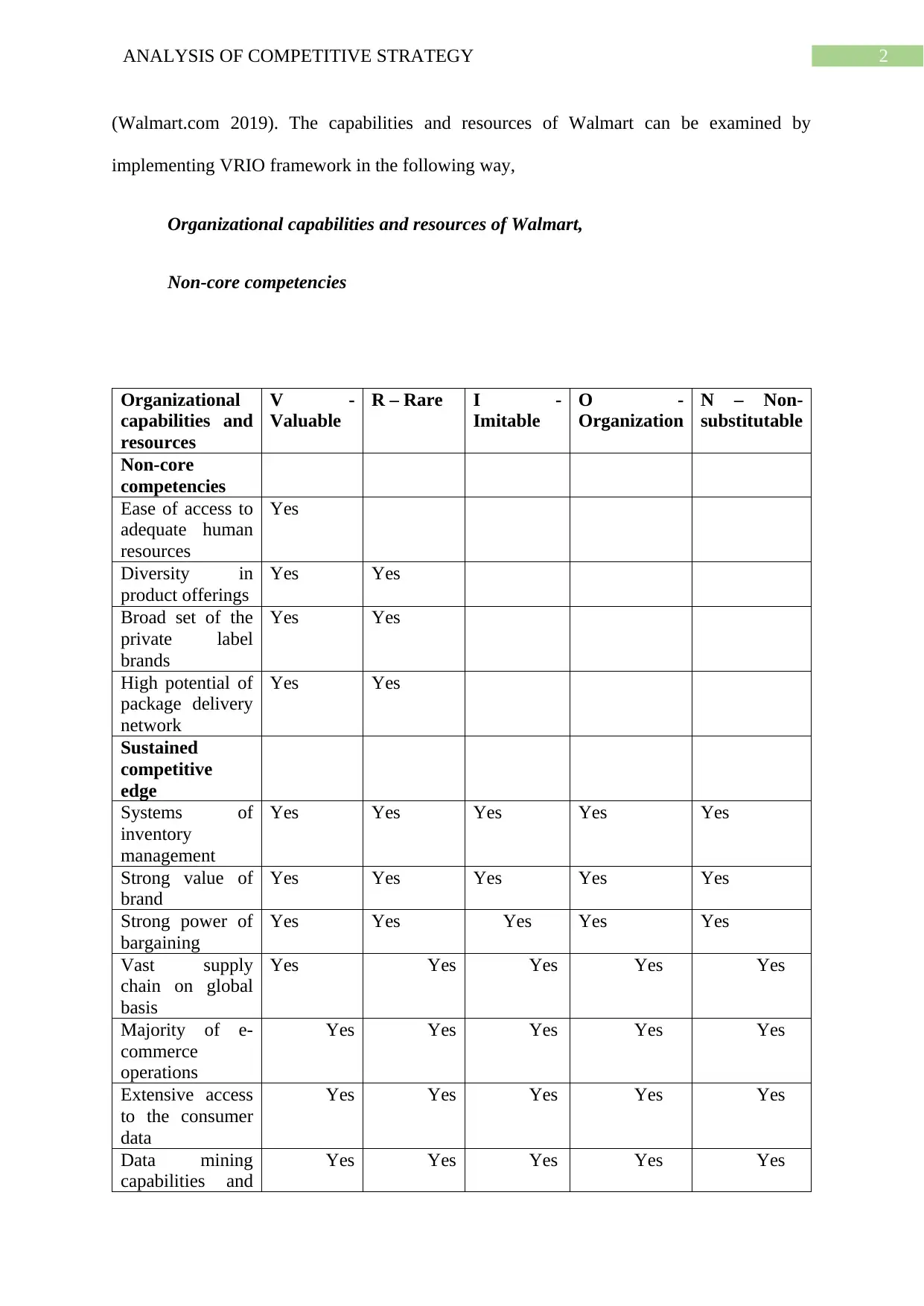
2ANALYSIS OF COMPETITIVE STRATEGY
(Walmart.com 2019). The capabilities and resources of Walmart can be examined by
implementing VRIO framework in the following way,
Organizational capabilities and resources of Walmart,
Non-core competencies
Organizational
capabilities and
resources
V -
Valuable
R – Rare I -
Imitable
O -
Organization
N – Non-
substitutable
Non-core
competencies
Ease of access to
adequate human
resources
Yes
Diversity in
product offerings
Yes Yes
Broad set of the
private label
brands
Yes Yes
High potential of
package delivery
network
Yes Yes
Sustained
competitive
edge
Systems of
inventory
management
Yes Yes Yes Yes Yes
Strong value of
brand
Yes Yes Yes Yes Yes
Strong power of
bargaining
Yes Yes Yes Yes Yes
Vast supply
chain on global
basis
Yes Yes Yes Yes Yes
Majority of e-
commerce
operations
Yes Yes Yes Yes Yes
Extensive access
to the consumer
data
Yes Yes Yes Yes Yes
Data mining
capabilities and
Yes Yes Yes Yes Yes
(Walmart.com 2019). The capabilities and resources of Walmart can be examined by
implementing VRIO framework in the following way,
Organizational capabilities and resources of Walmart,
Non-core competencies
Organizational
capabilities and
resources
V -
Valuable
R – Rare I -
Imitable
O -
Organization
N – Non-
substitutable
Non-core
competencies
Ease of access to
adequate human
resources
Yes
Diversity in
product offerings
Yes Yes
Broad set of the
private label
brands
Yes Yes
High potential of
package delivery
network
Yes Yes
Sustained
competitive
edge
Systems of
inventory
management
Yes Yes Yes Yes Yes
Strong value of
brand
Yes Yes Yes Yes Yes
Strong power of
bargaining
Yes Yes Yes Yes Yes
Vast supply
chain on global
basis
Yes Yes Yes Yes Yes
Majority of e-
commerce
operations
Yes Yes Yes Yes Yes
Extensive access
to the consumer
data
Yes Yes Yes Yes Yes
Data mining
capabilities and
Yes Yes Yes Yes Yes
⊘ This is a preview!⊘
Do you want full access?
Subscribe today to unlock all pages.

Trusted by 1+ million students worldwide
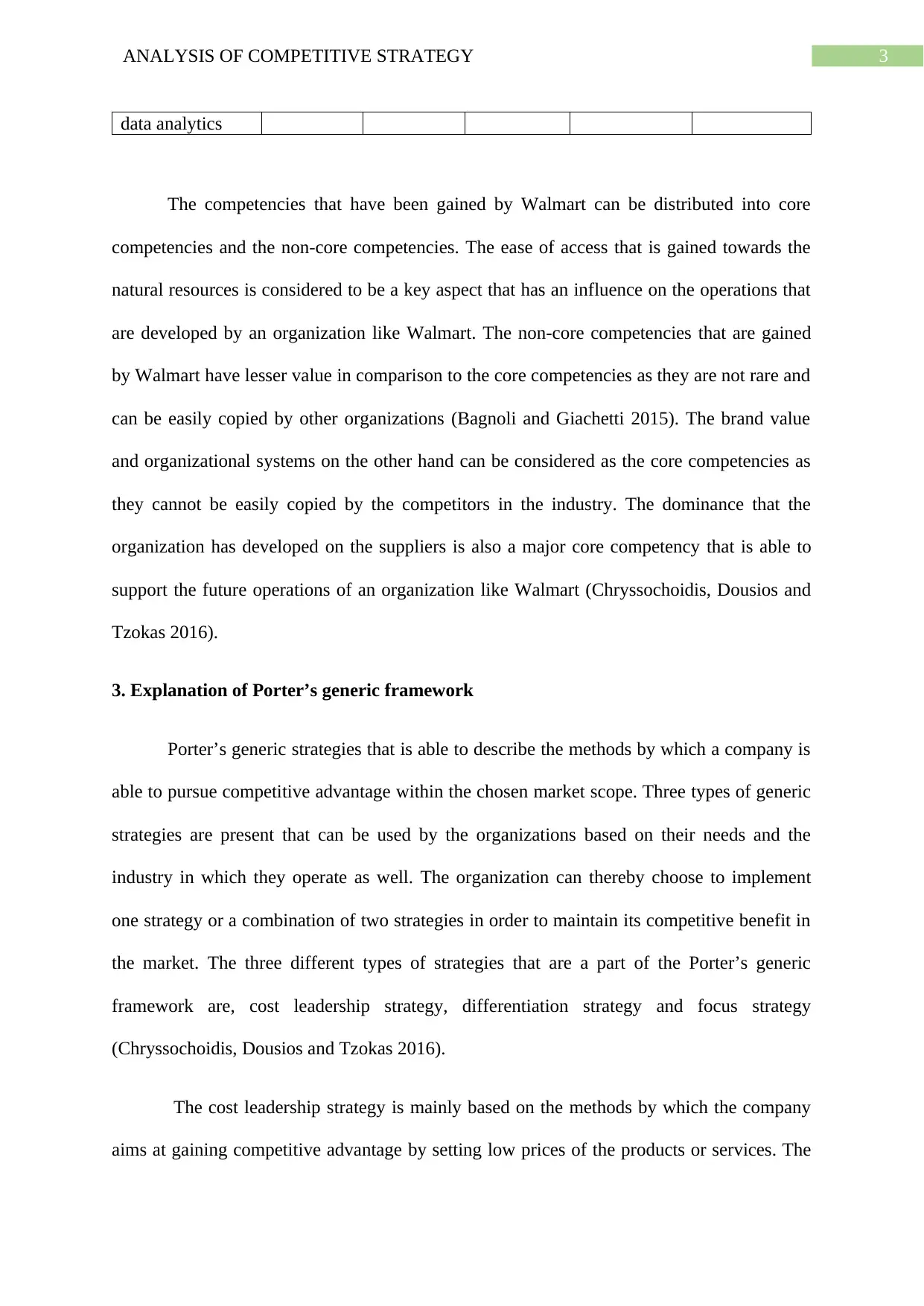
3ANALYSIS OF COMPETITIVE STRATEGY
data analytics
The competencies that have been gained by Walmart can be distributed into core
competencies and the non-core competencies. The ease of access that is gained towards the
natural resources is considered to be a key aspect that has an influence on the operations that
are developed by an organization like Walmart. The non-core competencies that are gained
by Walmart have lesser value in comparison to the core competencies as they are not rare and
can be easily copied by other organizations (Bagnoli and Giachetti 2015). The brand value
and organizational systems on the other hand can be considered as the core competencies as
they cannot be easily copied by the competitors in the industry. The dominance that the
organization has developed on the suppliers is also a major core competency that is able to
support the future operations of an organization like Walmart (Chryssochoidis, Dousios and
Tzokas 2016).
3. Explanation of Porter’s generic framework
Porter’s generic strategies that is able to describe the methods by which a company is
able to pursue competitive advantage within the chosen market scope. Three types of generic
strategies are present that can be used by the organizations based on their needs and the
industry in which they operate as well. The organization can thereby choose to implement
one strategy or a combination of two strategies in order to maintain its competitive benefit in
the market. The three different types of strategies that are a part of the Porter’s generic
framework are, cost leadership strategy, differentiation strategy and focus strategy
(Chryssochoidis, Dousios and Tzokas 2016).
The cost leadership strategy is mainly based on the methods by which the company
aims at gaining competitive advantage by setting low prices of the products or services. The
data analytics
The competencies that have been gained by Walmart can be distributed into core
competencies and the non-core competencies. The ease of access that is gained towards the
natural resources is considered to be a key aspect that has an influence on the operations that
are developed by an organization like Walmart. The non-core competencies that are gained
by Walmart have lesser value in comparison to the core competencies as they are not rare and
can be easily copied by other organizations (Bagnoli and Giachetti 2015). The brand value
and organizational systems on the other hand can be considered as the core competencies as
they cannot be easily copied by the competitors in the industry. The dominance that the
organization has developed on the suppliers is also a major core competency that is able to
support the future operations of an organization like Walmart (Chryssochoidis, Dousios and
Tzokas 2016).
3. Explanation of Porter’s generic framework
Porter’s generic strategies that is able to describe the methods by which a company is
able to pursue competitive advantage within the chosen market scope. Three types of generic
strategies are present that can be used by the organizations based on their needs and the
industry in which they operate as well. The organization can thereby choose to implement
one strategy or a combination of two strategies in order to maintain its competitive benefit in
the market. The three different types of strategies that are a part of the Porter’s generic
framework are, cost leadership strategy, differentiation strategy and focus strategy
(Chryssochoidis, Dousios and Tzokas 2016).
The cost leadership strategy is mainly based on the methods by which the company
aims at gaining competitive advantage by setting low prices of the products or services. The
Paraphrase This Document
Need a fresh take? Get an instant paraphrase of this document with our AI Paraphraser

4ANALYSIS OF COMPETITIVE STRATEGY
differentiation strategy is based on the development of a major differentiation of the services
or products in order to maintain its position in the industry (Hernández-Perlines, Moreno-
García and Yañez-Araque 2016). The differentiation of products can be based on the quality
and levels of benefits that are provided to the customers as well. The focus strategy on the
other hand is based on the focus that is provided by the organizations to certain types of
customers. Focus strategy can also be a mix of two types of generic strategies that are
proposed by Porter (Grant 2016).
The example of Apple Inc. can be considered in order to understand the
implementation of generic strategies in the organizations. Apple has implemented broad
differentiation strategy for offering products to the customers. The premium quality of
products is able to play a major role in growth of the position of the firm in minds of
consumers. The high prices are not a concern for the customers as they are interested in the
features that are offered by the products. The brand value of Apple is also an important factor
that has an impact on the sales of the organization (Apple.com 2019).
Apple Inc. has gained major success in the technology and smartphone industry with
the support that is provided by high quality products of the organization. Premium brand
value is able to play the most significant part in supporting to Apple to maintain its consumer
base for a long period of time. Apple Inc. has also gained a competitive advantage in the
technology industry by providing the best quality products to customers. Broad
differentiation strategy has also helped Apple to focus on the main features of the products
rather than concentrating on the prices (Grant 2016).
4. Explanation of SWOT framework
SWOT framework helps the business organization to identify the mistakes that are
being made in the course of its operations. SWOT analysis is also considered to be a major
differentiation strategy is based on the development of a major differentiation of the services
or products in order to maintain its position in the industry (Hernández-Perlines, Moreno-
García and Yañez-Araque 2016). The differentiation of products can be based on the quality
and levels of benefits that are provided to the customers as well. The focus strategy on the
other hand is based on the focus that is provided by the organizations to certain types of
customers. Focus strategy can also be a mix of two types of generic strategies that are
proposed by Porter (Grant 2016).
The example of Apple Inc. can be considered in order to understand the
implementation of generic strategies in the organizations. Apple has implemented broad
differentiation strategy for offering products to the customers. The premium quality of
products is able to play a major role in growth of the position of the firm in minds of
consumers. The high prices are not a concern for the customers as they are interested in the
features that are offered by the products. The brand value of Apple is also an important factor
that has an impact on the sales of the organization (Apple.com 2019).
Apple Inc. has gained major success in the technology and smartphone industry with
the support that is provided by high quality products of the organization. Premium brand
value is able to play the most significant part in supporting to Apple to maintain its consumer
base for a long period of time. Apple Inc. has also gained a competitive advantage in the
technology industry by providing the best quality products to customers. Broad
differentiation strategy has also helped Apple to focus on the main features of the products
rather than concentrating on the prices (Grant 2016).
4. Explanation of SWOT framework
SWOT framework helps the business organization to identify the mistakes that are
being made in the course of its operations. SWOT analysis is also considered to be a major

5ANALYSIS OF COMPETITIVE STRATEGY
planning based methodology that is used by the firms to build the strategic plan for meeting
the goals and the objectives and to improve the operations as well. The business operations
can remain relevant in the industry with the help of proper usage of the SWOT analysis
framework (Hernández-Perlines, Moreno-García and Yañez-Araque 2016). The use of
SWOT framework can be understood with the help of the example of Amazon.com.
Strengths – The strong brand value that has been gained by Amazon is a major
strength of the organization. Business diversification is considered to be an important aspect
that is related to the string position that is gained by the organization. The online retail market
has been totally captured by Amazon and the technological innovation have been able to
support the growth of the organization as well. The rapid growth of Amazon is also based on
the high levels of awareness that have been developed by the brand in retail market
(Amazon.com 2019).
Weaknesses – The business model formed by Amazon.com is imitable in nature and
this can have an adverse impact on the competitive advantage that is gained by the company.
The penetration of Amazon in the developing or emerging markets is quite low and it has
proved to be a major weakness of the organization. The brick-and-mortar presence of
Amazon is limited and it is considered to a significant weakness of the organization. The
physical retailers are able to offer key levels of competition to the organization and have an
impact on the revenue levels as well (Morgan and Strong 2015).
Opportunities – Amazon.com has the opportunity to grow its processes in the
developing markets or the emerging economies. The proper expansion of brick-and-mortar
operations is also considered as a major opportunity of growth of Amazon. Partnerships that
have been made with the firms in developing markets have an impact on the operations and
growth of Amazon.
planning based methodology that is used by the firms to build the strategic plan for meeting
the goals and the objectives and to improve the operations as well. The business operations
can remain relevant in the industry with the help of proper usage of the SWOT analysis
framework (Hernández-Perlines, Moreno-García and Yañez-Araque 2016). The use of
SWOT framework can be understood with the help of the example of Amazon.com.
Strengths – The strong brand value that has been gained by Amazon is a major
strength of the organization. Business diversification is considered to be an important aspect
that is related to the string position that is gained by the organization. The online retail market
has been totally captured by Amazon and the technological innovation have been able to
support the growth of the organization as well. The rapid growth of Amazon is also based on
the high levels of awareness that have been developed by the brand in retail market
(Amazon.com 2019).
Weaknesses – The business model formed by Amazon.com is imitable in nature and
this can have an adverse impact on the competitive advantage that is gained by the company.
The penetration of Amazon in the developing or emerging markets is quite low and it has
proved to be a major weakness of the organization. The brick-and-mortar presence of
Amazon is limited and it is considered to a significant weakness of the organization. The
physical retailers are able to offer key levels of competition to the organization and have an
impact on the revenue levels as well (Morgan and Strong 2015).
Opportunities – Amazon.com has the opportunity to grow its processes in the
developing markets or the emerging economies. The proper expansion of brick-and-mortar
operations is also considered as a major opportunity of growth of Amazon. Partnerships that
have been made with the firms in developing markets have an impact on the operations and
growth of Amazon.
⊘ This is a preview!⊘
Do you want full access?
Subscribe today to unlock all pages.

Trusted by 1+ million students worldwide
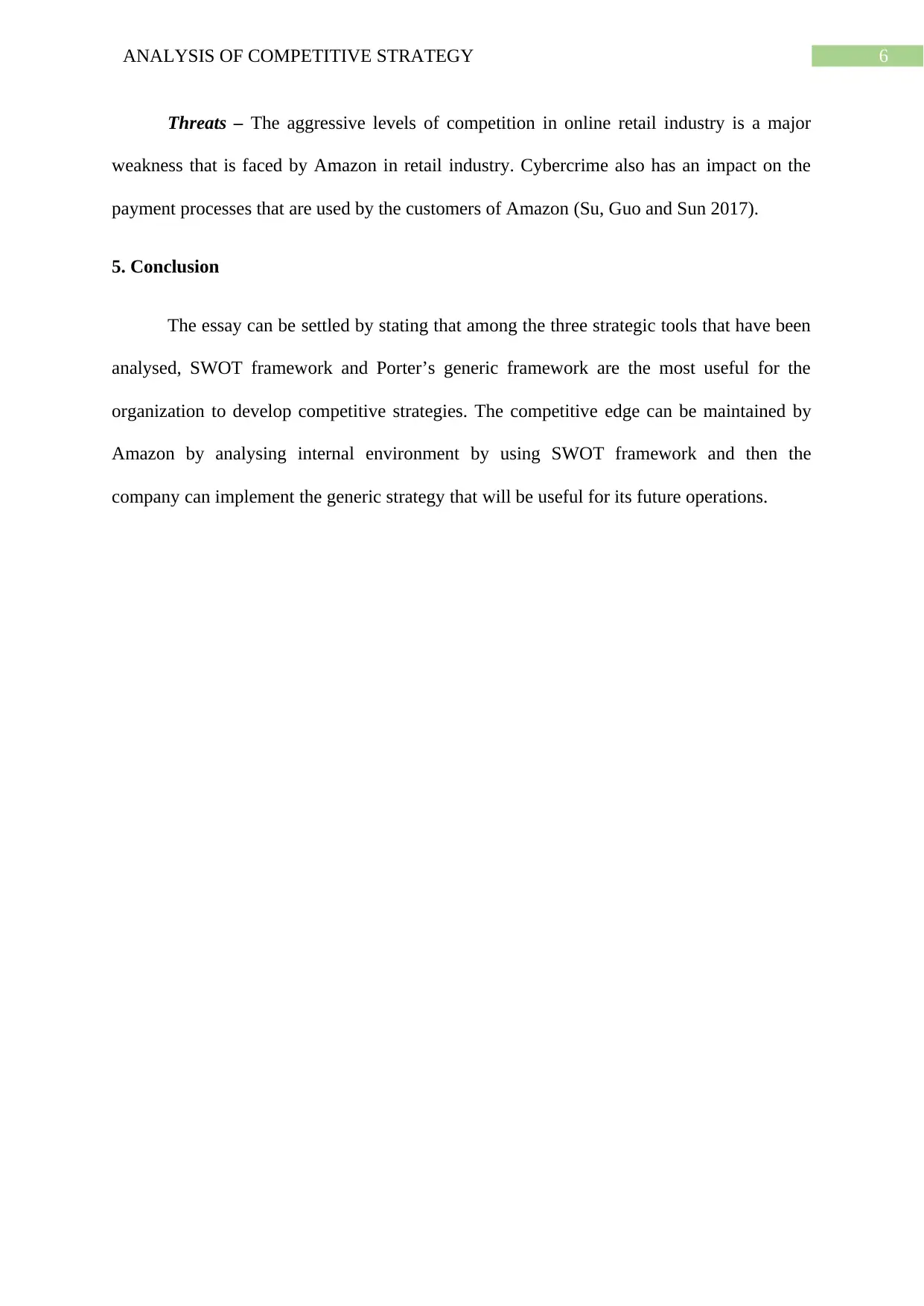
6ANALYSIS OF COMPETITIVE STRATEGY
Threats – The aggressive levels of competition in online retail industry is a major
weakness that is faced by Amazon in retail industry. Cybercrime also has an impact on the
payment processes that are used by the customers of Amazon (Su, Guo and Sun 2017).
5. Conclusion
The essay can be settled by stating that among the three strategic tools that have been
analysed, SWOT framework and Porter’s generic framework are the most useful for the
organization to develop competitive strategies. The competitive edge can be maintained by
Amazon by analysing internal environment by using SWOT framework and then the
company can implement the generic strategy that will be useful for its future operations.
Threats – The aggressive levels of competition in online retail industry is a major
weakness that is faced by Amazon in retail industry. Cybercrime also has an impact on the
payment processes that are used by the customers of Amazon (Su, Guo and Sun 2017).
5. Conclusion
The essay can be settled by stating that among the three strategic tools that have been
analysed, SWOT framework and Porter’s generic framework are the most useful for the
organization to develop competitive strategies. The competitive edge can be maintained by
Amazon by analysing internal environment by using SWOT framework and then the
company can implement the generic strategy that will be useful for its future operations.
Paraphrase This Document
Need a fresh take? Get an instant paraphrase of this document with our AI Paraphraser
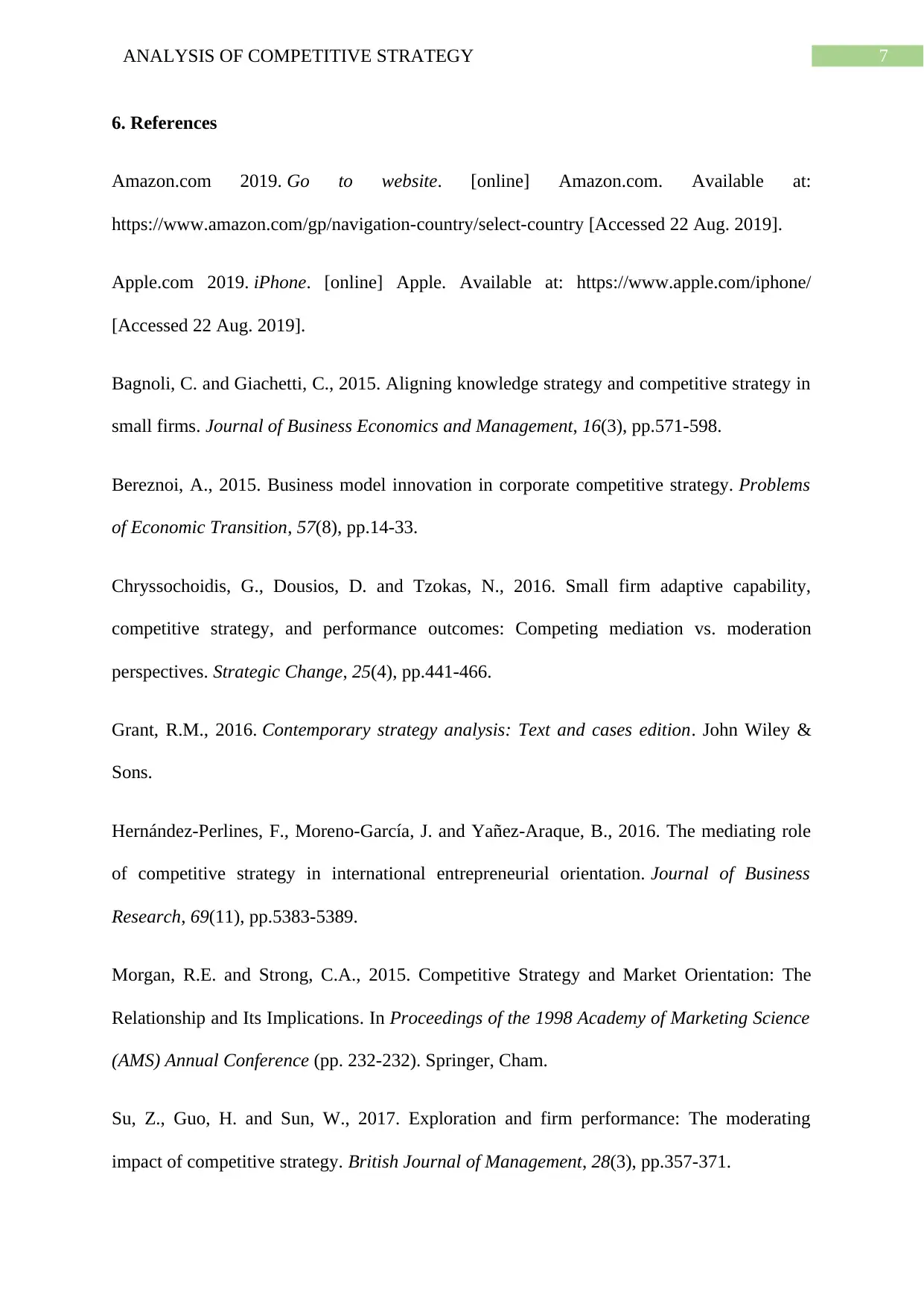
7ANALYSIS OF COMPETITIVE STRATEGY
6. References
Amazon.com 2019. Go to website. [online] Amazon.com. Available at:
https://www.amazon.com/gp/navigation-country/select-country [Accessed 22 Aug. 2019].
Apple.com 2019. iPhone. [online] Apple. Available at: https://www.apple.com/iphone/
[Accessed 22 Aug. 2019].
Bagnoli, C. and Giachetti, C., 2015. Aligning knowledge strategy and competitive strategy in
small firms. Journal of Business Economics and Management, 16(3), pp.571-598.
Bereznoi, A., 2015. Business model innovation in corporate competitive strategy. Problems
of Economic Transition, 57(8), pp.14-33.
Chryssochoidis, G., Dousios, D. and Tzokas, N., 2016. Small firm adaptive capability,
competitive strategy, and performance outcomes: Competing mediation vs. moderation
perspectives. Strategic Change, 25(4), pp.441-466.
Grant, R.M., 2016. Contemporary strategy analysis: Text and cases edition. John Wiley &
Sons.
Hernández-Perlines, F., Moreno-García, J. and Yañez-Araque, B., 2016. The mediating role
of competitive strategy in international entrepreneurial orientation. Journal of Business
Research, 69(11), pp.5383-5389.
Morgan, R.E. and Strong, C.A., 2015. Competitive Strategy and Market Orientation: The
Relationship and Its Implications. In Proceedings of the 1998 Academy of Marketing Science
(AMS) Annual Conference (pp. 232-232). Springer, Cham.
Su, Z., Guo, H. and Sun, W., 2017. Exploration and firm performance: The moderating
impact of competitive strategy. British Journal of Management, 28(3), pp.357-371.
6. References
Amazon.com 2019. Go to website. [online] Amazon.com. Available at:
https://www.amazon.com/gp/navigation-country/select-country [Accessed 22 Aug. 2019].
Apple.com 2019. iPhone. [online] Apple. Available at: https://www.apple.com/iphone/
[Accessed 22 Aug. 2019].
Bagnoli, C. and Giachetti, C., 2015. Aligning knowledge strategy and competitive strategy in
small firms. Journal of Business Economics and Management, 16(3), pp.571-598.
Bereznoi, A., 2015. Business model innovation in corporate competitive strategy. Problems
of Economic Transition, 57(8), pp.14-33.
Chryssochoidis, G., Dousios, D. and Tzokas, N., 2016. Small firm adaptive capability,
competitive strategy, and performance outcomes: Competing mediation vs. moderation
perspectives. Strategic Change, 25(4), pp.441-466.
Grant, R.M., 2016. Contemporary strategy analysis: Text and cases edition. John Wiley &
Sons.
Hernández-Perlines, F., Moreno-García, J. and Yañez-Araque, B., 2016. The mediating role
of competitive strategy in international entrepreneurial orientation. Journal of Business
Research, 69(11), pp.5383-5389.
Morgan, R.E. and Strong, C.A., 2015. Competitive Strategy and Market Orientation: The
Relationship and Its Implications. In Proceedings of the 1998 Academy of Marketing Science
(AMS) Annual Conference (pp. 232-232). Springer, Cham.
Su, Z., Guo, H. and Sun, W., 2017. Exploration and firm performance: The moderating
impact of competitive strategy. British Journal of Management, 28(3), pp.357-371.
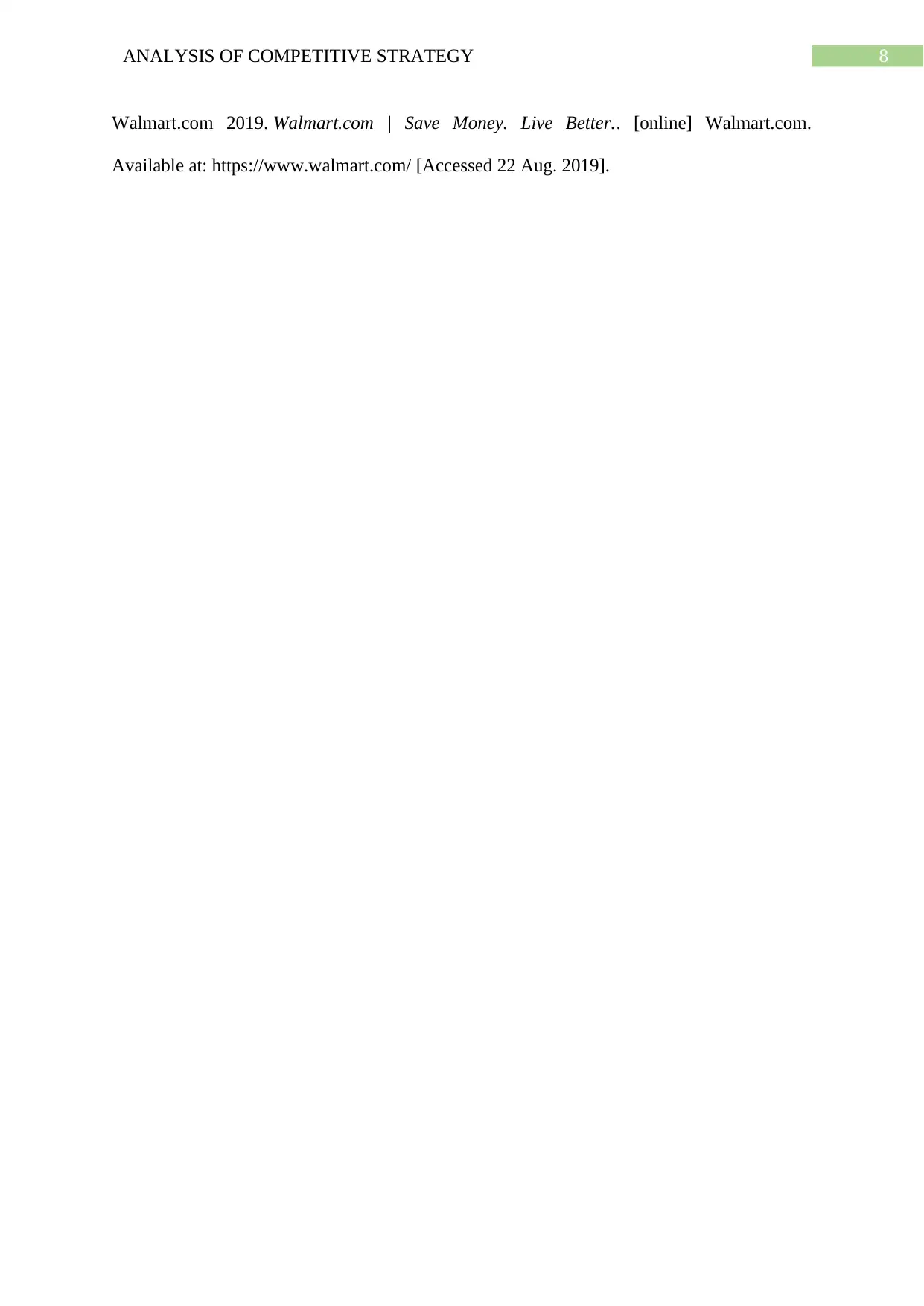
8ANALYSIS OF COMPETITIVE STRATEGY
Walmart.com 2019. Walmart.com | Save Money. Live Better.. [online] Walmart.com.
Available at: https://www.walmart.com/ [Accessed 22 Aug. 2019].
Walmart.com 2019. Walmart.com | Save Money. Live Better.. [online] Walmart.com.
Available at: https://www.walmart.com/ [Accessed 22 Aug. 2019].
⊘ This is a preview!⊘
Do you want full access?
Subscribe today to unlock all pages.

Trusted by 1+ million students worldwide
1 out of 9
Related Documents
Your All-in-One AI-Powered Toolkit for Academic Success.
+13062052269
info@desklib.com
Available 24*7 on WhatsApp / Email
![[object Object]](/_next/static/media/star-bottom.7253800d.svg)
Unlock your academic potential
Copyright © 2020–2025 A2Z Services. All Rights Reserved. Developed and managed by ZUCOL.





